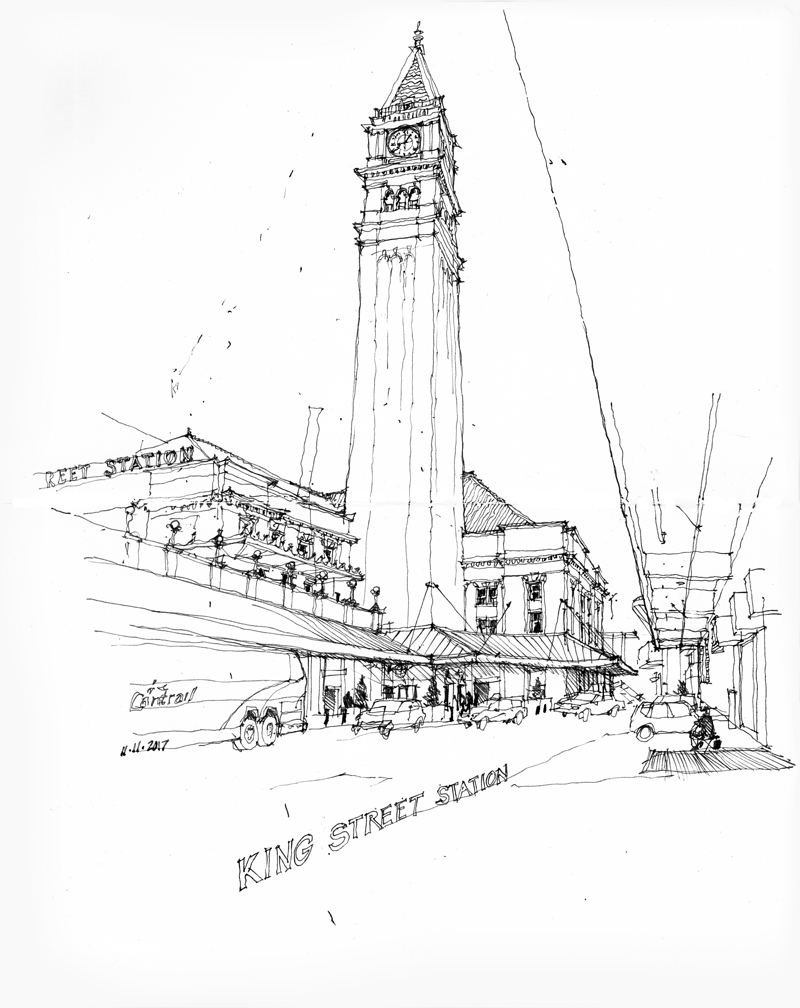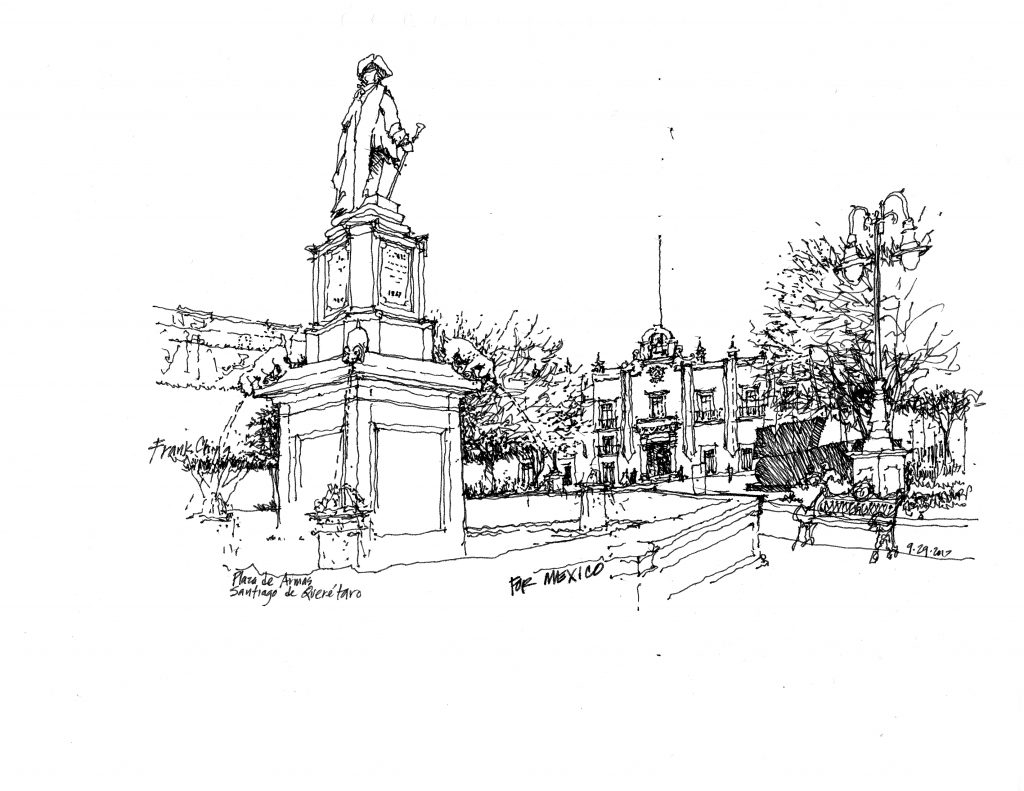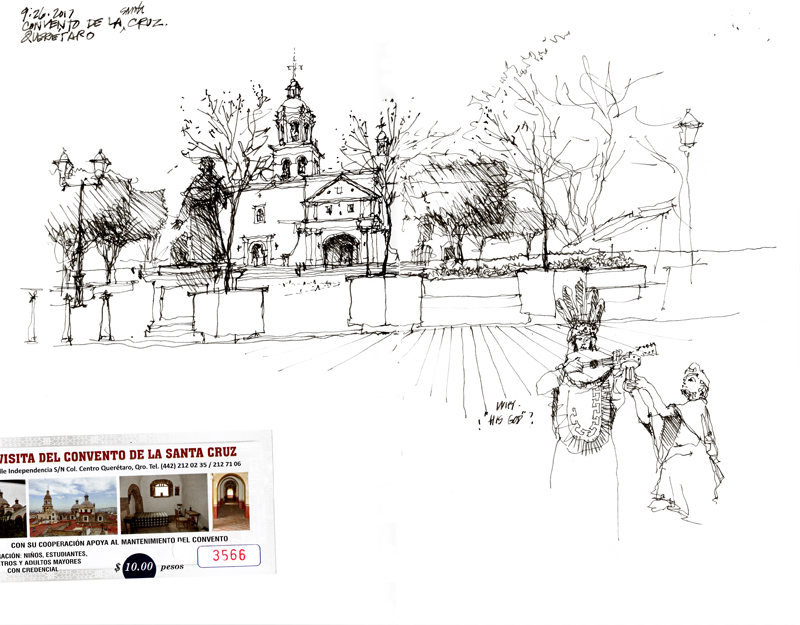More examples of how changes in media affect not how one sees, but rather how one captures what is seen—the pace of the line, the level and precision of detail, and the voids that speak to the eye.

The several times I had the privilege of teaching in the University of Washington’s Architecture in Rome program, I asked my students to keep a journal during the semester to record and document their history walks, field trips, and design studio work. To try and set an example, I kept my own sketchbook along with them. Here are a few sample pages showing how my drawings changed due to the passage of time as well as how my trusty Lamy fountain pen interacted with the different types of paper I used.
 On Saturday, November 11, 2017, Seattle Urban Sketchers met at King Street Station to help mark the 10th anniversary of USk. USk chapters around the world, beginning in New Zealand and ending in Honolulu, participated in this Global 24-Hour Sketchwalk.
On Saturday, November 11, 2017, Seattle Urban Sketchers met at King Street Station to help mark the 10th anniversary of USk. USk chapters around the world, beginning in New Zealand and ending in Honolulu, participated in this Global 24-Hour Sketchwalk.
Completed in 1906 to serve both the Great Northern and Northern Pacific railways, King Street Station now serves Amtrak and the Sound Transit Sounder commuter trains. The Minnesota firm of Reed and Stem designed the station, which was listed in the National Register of Historic Places and the Washington Heritage Register in 1973. The tower featured in this sketch, with its height slightly exaggerated, was modeled after the Campanile in the Piazza San Marco in Venice.
Sakya, one of the four major schools of Tibetan Buddhism, is named after the patch of gray (kya) earth (sa) in southern Tibet on which its first monastery was erected in 1073. In contrast, this Sakya Monastery in the north Seattle neighborhood of Greenwood is housed in a former Presbyterian church built in 1928. After outgrowing several other facilities in Seattle, the local Sakya community moved here in 1984. This location was seen as being auspicious because the number 108 in its address is sacred in Tibetan Buddhism.
Rather than being a monastery, this is more a community of lay practitioners that was led by His Holiness Jigdal Dagchen Sakya Rinpoche, who immigrated to the U.S. with his family in 1960 as exiles after the Chinese invasion of Tibet. One of the first Tibetan lamas to settle and teach in the U.S., he passed away last year at the age of 87.
At the corner of the site where NW 83rd Street meets 1st Avenue NW is erected a white bell-shaped stupa in memory of Dezhung Rinpoche III, who had co-founded with Jigdal Dagchen the original Sakya Dharma Center in Seattle in 1974. The stupa, symbolizing the Buddha’s enlightened mind, is surrounded by four quadrants of prayer wheels
 Here is a view of Plaza de Armas, also known as the Plaza de Independencia, in Querétaro. In the foreground is a fountain with a statue of Juan Antonio de Urrutia y Arana, who was responsible for the construction of a 4200-foot long aqueduct to bring water to the city from La Cañada in the early 18th century. He is looking toward the Palacio de la Corregidora, residence of Don Miguel Domínguez and his wife Josefa Ortiz de Domínguez, who is revered for her role in liberating Mexico from Spain. The palace is now the seat of the state government of Querétaro.
Here is a view of Plaza de Armas, also known as the Plaza de Independencia, in Querétaro. In the foreground is a fountain with a statue of Juan Antonio de Urrutia y Arana, who was responsible for the construction of a 4200-foot long aqueduct to bring water to the city from La Cañada in the early 18th century. He is looking toward the Palacio de la Corregidora, residence of Don Miguel Domínguez and his wife Josefa Ortiz de Domínguez, who is revered for her role in liberating Mexico from Spain. The palace is now the seat of the state government of Querétaro.
Along the west side of the plaza is this view corridor, with a carefully pruned mass of Indian laurel trees on the left and on the right, the Casa de Ecala, an 18th-century baroque mansion named after Tomás López de Ecala. The casa is now home of DIF (Desarrollo Integral de La Familia), a state agency offering social assistance to Mexican families.
 The public enters the 1752 Church of Santa Rosa de Viterbo through twin entrances on the north side rather than the more typical west end, which abuts a busy street. This view is drawn from the Plaza Mariano de las Casas, created in 1964 to increase the visibility of this north side of the church.
The public enters the 1752 Church of Santa Rosa de Viterbo through twin entrances on the north side rather than the more typical west end, which abuts a busy street. This view is drawn from the Plaza Mariano de las Casas, created in 1964 to increase the visibility of this north side of the church.
Santa Rosa de Viterbo was originally associated with a convent whose nuns devoted themselves to primary education. After the convent was closed in 1861 due to the Reform Laws, the facility was transformed into a hospital. Today, the convent portion is the Centro de Estudios de Diseño y Artes Graficas Mexico-Italiano.
This past Sunday, Seattle Urban Sketchers ventured north to downtown Everett to visit the new flagship store of Funko, a company founded by Mike Becker in 1998 to produce low-tech, nostalgia-themed toys. Its first product was a bobblehead figure of the restaurant icon Big Boy. Now headed by Brian Mariotti, Funko has one of the largest portfolios in the pop culture industry. The store itself, a former Bon Marche and Macy’s, is a fantasyland of collectible toys licensed from such companies as Marvel, DC Comics, Disney, Nickelodeon, and many others. As I was drawing the exterior view, a line started forming to await the 11 am opening of the store and so I had to add those figures at the last minute. The view itself is like a panorama, but vertical instead of horizontal.
We often are enthralled with monuments and monumental buildings and do not pay enough attention to the uniqueness and beauty of the more mundane places we encounter. Here are a couple of views of the commonplace. The first is the short pedestrian-only Calle V. Carranza, in the historic center of Querétaro. At the east end of the narrow street stands a bust of Venustiano Carranza Garza (1859–1920), the first elected president of the newly formed Mexican Republic in 1917, after the Mexican Revolution of 1910, and under whose watch the 1917 Constitution was ratified.
The second view illustrates the power of a simple line drawing to capture a scene—this one a table at Maria y su Bici, a Oaxacan mezcaleria in Querétaro.
 The Franciscan Church and Monastery of Santa Cruz (Iglesia y Convento de la Santa Cruz) dates from the 16th century and is named for the pink stone cross on the main altar. This cross commemorates the appearance of St. James that was supposed to have occurred on July 25, 1531 as the Spanish and their Nahuan allies battled the Otomi and Chichimecas on the hill where the church and monastery are now located. The well preserved compound consists of a series of cloisters and monk’s cells, along with a kitchen, orchard, water reservoir, and related ancillary facilities.
The Franciscan Church and Monastery of Santa Cruz (Iglesia y Convento de la Santa Cruz) dates from the 16th century and is named for the pink stone cross on the main altar. This cross commemorates the appearance of St. James that was supposed to have occurred on July 25, 1531 as the Spanish and their Nahuan allies battled the Otomi and Chichimecas on the hill where the church and monastery are now located. The well preserved compound consists of a series of cloisters and monk’s cells, along with a kitchen, orchard, water reservoir, and related ancillary facilities.
The first missionary school in the Americas, the School for the Propagation of the Faith (Colegio de la Propagación de la Fe) was established here. From this school, Franciscan friars ventured forth to establish missions as far north as what is now Texas and California.
In one of the courtyards is a thorn tree which, according to legend, grew from the walking stick that the missionary Fray Antonio Margil de Jesús stuck in the ground during his stay at the monastery. What is notable is that the tree bears thorns having three spines in the shape of a cross.
I’ve spent a week in Santiago de Querétaro, a UNESCO World Heritage Site, exploring the historic center and drawing with a wonderful group of students from the School of Architecture, Art and Design at Tecnologico de Monterrey. At the end of the first day’s activities, as I was walking back to my hotel, this casa was pointed out to me. It was built in 1756 for the Marquesa de Villar and is now a boutique hotel. Seeing the richness of the entry court, I felt compelled to draw to stop and draw it. More drawings to come.